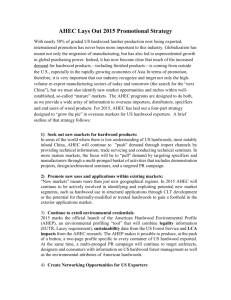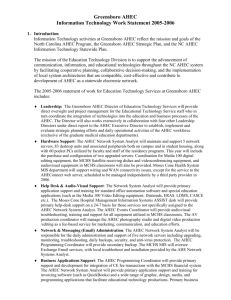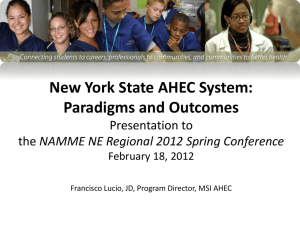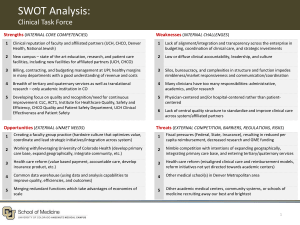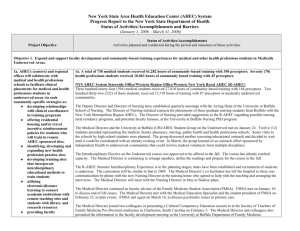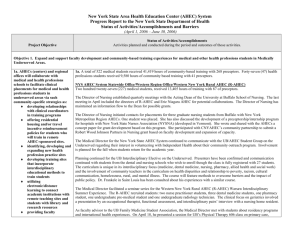AHEC Program - grantreviewinfo.net
advertisement
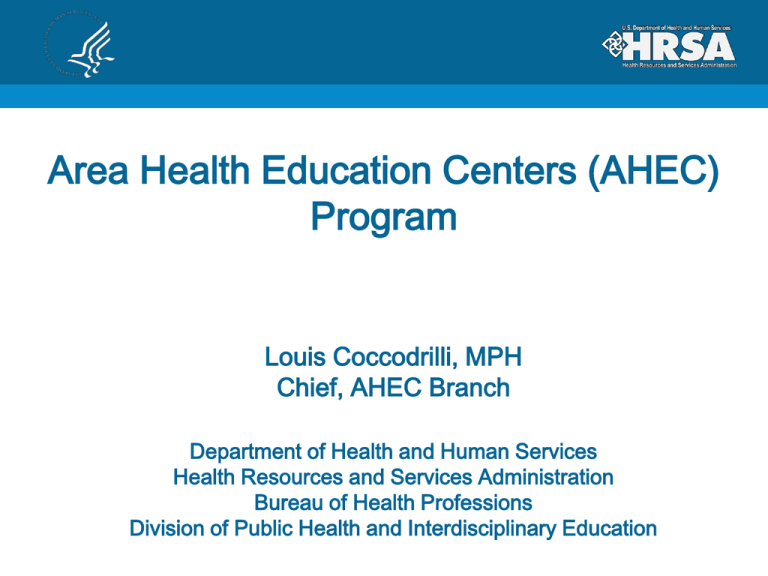
Area Health Education Centers (AHEC) Program Louis Coccodrilli, MPH Chief, AHEC Branch Department of Health and Human Services Health Resources and Services Administration Bureau of Health Professions Division of Public Health and Interdisciplinary Education Presentation Outline •AHEC Program Legislation & Purpose •AHEC Program & Center Requirements •Key Program Activities •Collaborations with Other Bureaus AHEC Program Established by Congress in 1971. Title VII, Section 751 of the Public Health Service Act (42 U.S.C. 294a), as amended by the Affordable Care Act (ACA), Public Law 111-148. Emphasis on developing a health care workforce that meets the primary care needs of communities. AHEC Program Provides grants to schools of medicine and nursing to establish and maintain communitybased training programs in off campus rural and/or underserved areas. In FY 2011, supports 57 AHEC programs contracting with 253 centers in 48 states, the District of Columbia, territories of Guam, Palau and Puerto Rico. AHEC Programmatic Phases Two Programmatic Phases: 1. Infrastructure Development (U76): Establishment of community-based AHEC centers. Initial development and implementation of interdisciplinary/interprofessional, community-based primary care training programs; and Health careers outreach to minority, disadvantaged, rural students. 2. Point of Service Maintenance and Enhancement (U77): Improving the effectiveness and capabilities of existing AHEC programs and AHEC Centers. Adjusting the AHEC program to respond to the changing demographics and health workforce needs of the state or region served. Eligibility – Public or nonprofit private accredited schools of allopathic medicine and osteopathic medicine and incorporated consortia made up of such schools, or the parent institutions of such schools. – In States and Territories in which no AHEC program is in operation, an accredited school of nursing is an eligible applicant. AHEC Program Required Activities A. Health Careers Recruitment, in coordination with Workforce Investment Boards; B. Community-based training and education, with an emphasis on primary care, for the purpose of developing and maintaining a diverse health care workforce; C. Field placements or preceptorships in conjunction with community-based organizations; AHEC Program Required Activities D. Interdisciplinary/interprofessional training that emphasizes primary care; E. Continuing education and information dissemination programs for health care professionals; F. Program and outcomes measurement and evaluation strategies; G.Youth public health programming to expose and recruit high school students into health careers. AHEC Performance Measures AHEC Outputs Most Recent Result * No. of medical students trained in community sites in rural/underserved areas 20,758 No. of associated health professions students trained in community sites in rural/underserved areas 28,366 No. of training partnerships with community/migrant health centers and other underserved area sites 7,910 No. of local providers receiving continuing education and employed in medically underserved areas 54,056 No. of high school students (grades 9-12) participating in > 20 hours of health career training and/or academic enhancement experience 19,038 * Most Recent Result: Academic Year 2010/2011 (unduplicated numbers) AHEC Center Requirements Each AHEC center: Must be a public or private organization, whose structure, governance, and operation is independent from the awardee, and the parent institution of the awardee; Is not a school of medicine or osteopathic medicine, the parent institution of such a school, or a branch campus or subunit of the awardee or its parent institution, or a consortium of such entities; AHEC Center Requirements Each AHEC Center: Serves communities with a demonstrated need of health professionals in partnership with academic medical centers; Addresses the health care workforce needs of the communities served in coordination with the public workforce investment system; and Has a community-based governing or advisory board that reflects the diversity of the communities served. AHEC Center Requirements • In an AHEC program, AHEC centers receive 75% of the Federal awards via contracts negotiated with grantees. • Each AHEC center in an AHEC program may not receive the same amount of funds. AHEC Collaborations Coordination with the Department of Labor & Workforce Investment Boards Collaboration with BCRS National Health Service Corps NHSC Ambassadors Program SEARCH Health Careers Opportunity Program Bureau of Primary Health Care Community Health Centers/Federally Qualified Health Centers, Migrant and Rural Health Clinics Office of Health Information Technology and Quality AHEC Collaborations • Veterans Mental & Behavioral Health Training Initiative (HRSA/BHPr/DPHIE-AHEC and SAMHSA) Focus: AHEC grantees and local providers serving veterans and their families. Contact Information Mariquita G. Mullan, M.P.H., Ph.D. Director, Division of Public Health & Interdisciplinary Education Bureau of Health Professions/HRSA Phone: (301) 443-6758 E-mail: MMullan@hrsa.gov Meseret Bezuneh, M.S.Ed . Public Health Analyst/Project Officer Phone: (301) 594-4149 E-mail: mbezuneh@hrsa.gov Michelle Menser, MPH Public Health Analyst/Project Officer Phone (301) 443-6853 E-mail: mmenser@hrsa.gov Louis Coccodrilli, MPH, Rph Chief, AHEC Branch Division of Public Health & Interdisciplinary Education Bureau of Health Professions/HRSA Phone: (301) 443-7774 E-mail: lcoccodrilli@hrsa.gov Norma J. Hatot, CAPT Acting Chief, Public Health Branch Division of Public Health & Interdisciplinary Education Bureau of Health Professions/HRSA Phone: 301-443-2681 E-mail: nhatot@hrsa.gov AHEC Branch Main Telephone Number: 301-443-6950 Fax: 301-443-0157 Website: http://bhpr.hrsa.gov/grants/areahealtheducationcenters/index.html


